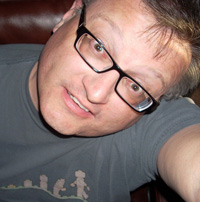

I was born a month before John Glenn became the first American in orbit. I became interested in geology, space exploration, and science fiction by the time Apollo 8 orbited the moon. I added writing, astronomy, and history to my interests by the time the Viking landers sought life on Mars.
I earned a Master's degree in History in 1987, the same year I made my first writing sale. I worked in planetariums in Illinois and Florida from 1987 to 1992. From 1992 to 1995, I served as Senior Technical Writer and Historian at NASA's Johnson Space Center in Houston, Texas. After a brief stint as editor of Star Date magazine, I became a full-time freelance science writer in November 1995. In October 2007, I left the full-time freelance writing world to become Manager of the Regional Planetary Information Facility at the U.S. Geological Survey in Flagstaff, Arizona.
 Astronomy, Air & Space Smithsonian, and other popular-audience magazines have carried my byline, and I have contributed more than 200 spaceflight and planetary science articles to encyclopedias. I also wrote exhibit text for the Astronaut Hall of Fame (1997), the Kansas Cosmosphere (2005), and other museums, and have contributed more than 400 scripts on a wide range of topics to the Earth & Sky, Star Date, and Earth Notes radio series (1992-2007).
Astronomy, Air & Space Smithsonian, and other popular-audience magazines have carried my byline, and I have contributed more than 200 spaceflight and planetary science articles to encyclopedias. I also wrote exhibit text for the Astronaut Hall of Fame (1997), the Kansas Cosmosphere (2005), and other museums, and have contributed more than 400 scripts on a wide range of topics to the Earth & Sky, Star Date, and Earth Notes radio series (1992-2007).
I have written several histories for NASA, including Thirty Years Together: A Chronology of U.S./Soviet Space Cooperation (1993), Mir Hardware Heritage (1995), Walking to Olympus: an EVA Chronology (1997), Orbital Debris: A Chronology (1999), and Humans to Mars: Fifty Years of Mission Planning, 1950-2000 (2001). The International Academy of Astronautics gave Walking to Olympus its Napolitano Book Award in 1998. Most of my space history writing at present is published on my Beyond Apollo blog, which is hosted at WIRED.
I have participated in astronomy education projects since 1986. I was education coordinator at the John Young Planetarium in Orlando, Florida (1987-89), taught classes in Illinois State University's College for Youth (1990-1992), "commanded" Young Astronauts chapters (1986-1989), and served as vice-president of the Johnson Space Center Astronomical Society (1994-1995). From 2002 to 2007, I taught astronomy and conducted star parties at middle and elementary schools on the Navajo and Hopi Reservations as part of the Navajo-Hopi Astronomy Outreach Program at Lowell Observatory in Flagstaff, Arizona. Since 2009, I have served as a mentor for NASA Space Grant Interns four times and organized USGS Astrogeology's contribution to Flagstaff's annual Science in the Park outreach event five times.
I trace my developing interest in environmental history to the seven years I spent in Houston, one of America's most polluted, sprawling, and environmentally vulnerable cities, and to my stint as the NASA/Earth & Sky Broadcast Fellow covering the Earth Science Enterprise at Goddard Space Flight Center, near Washington, D.C. (2000). In keeping with my enthusiasm for astronomy, much of my research to date has focused on light pollution. My article "Flagstaff's Battle for Dark Skies" won second prize in the Boeing/Griffith Observatory Science Writing Contest in 2002.
This I believe: that exploration is its own justification; that just enough is plenty; that those who don't know history are pretty much out to sea; and that everyone should work to give everyone else opportunities to achieve great things.
December 2013